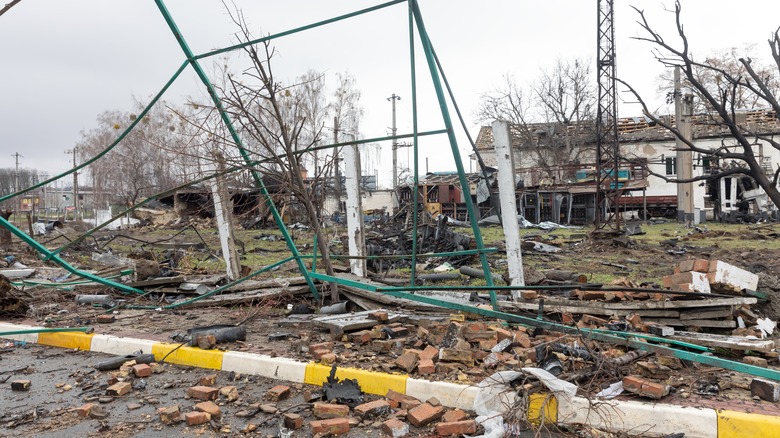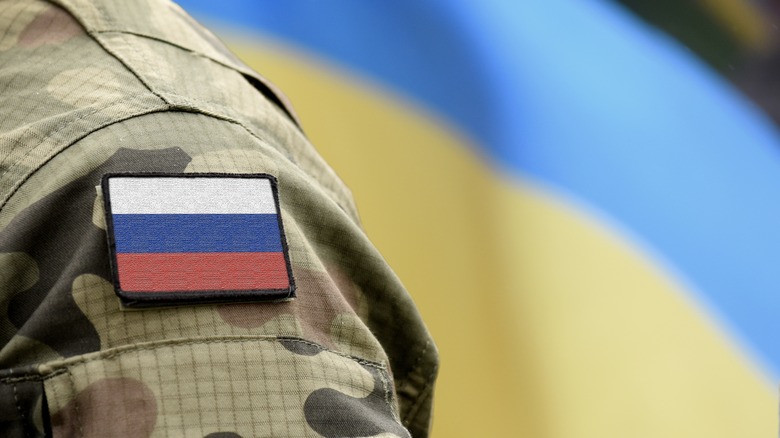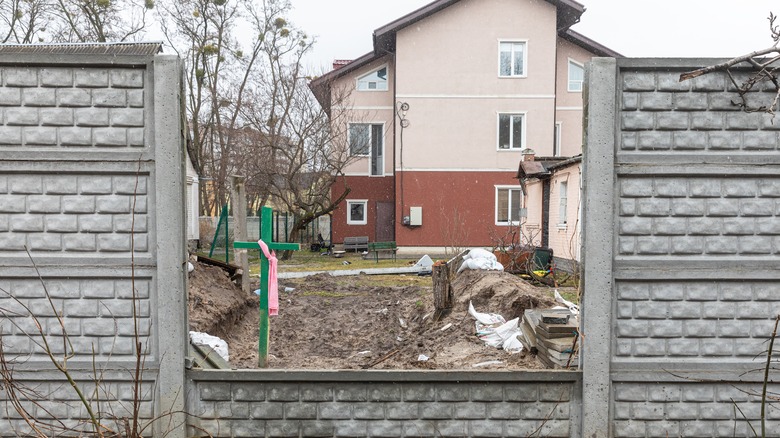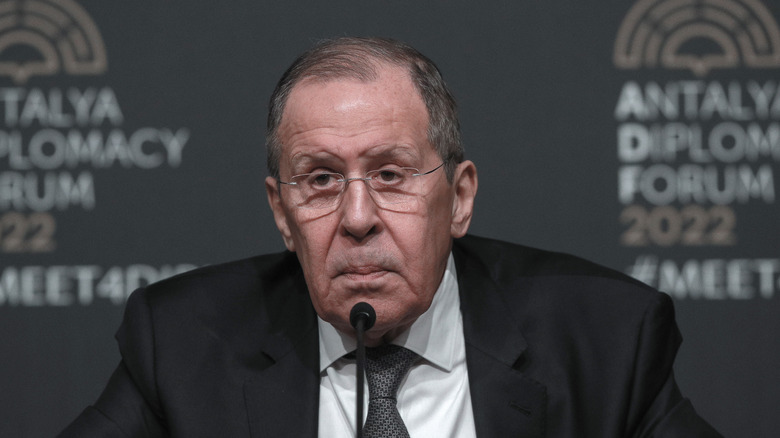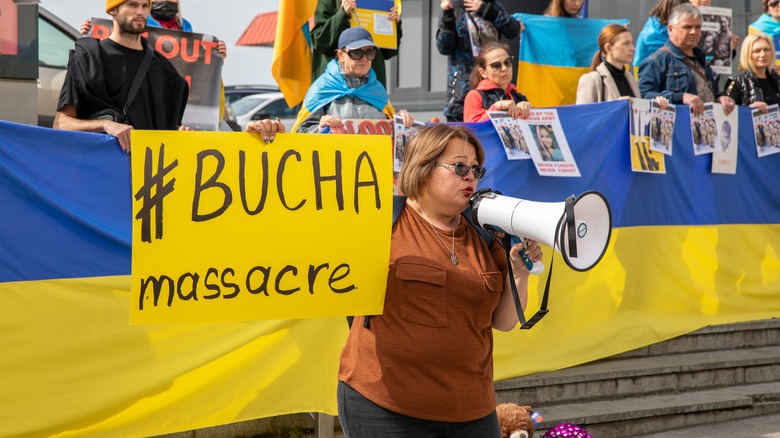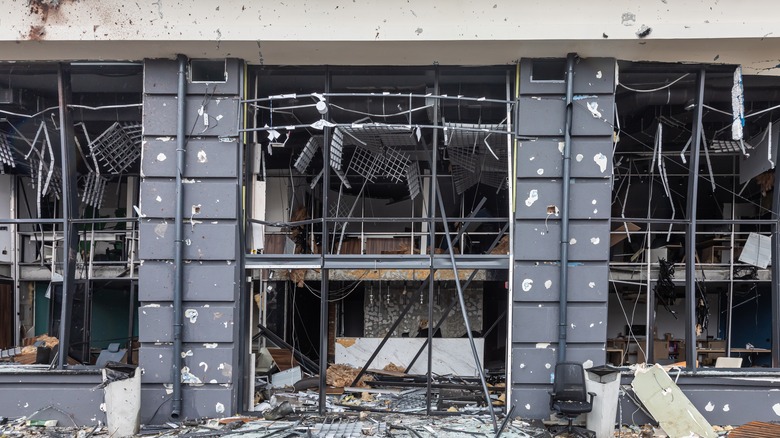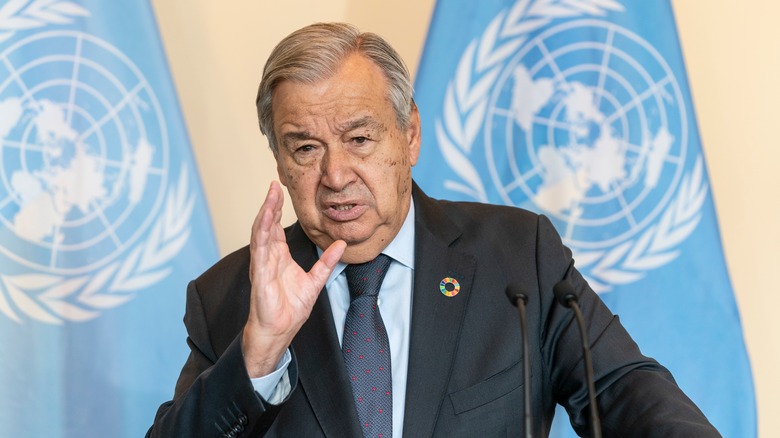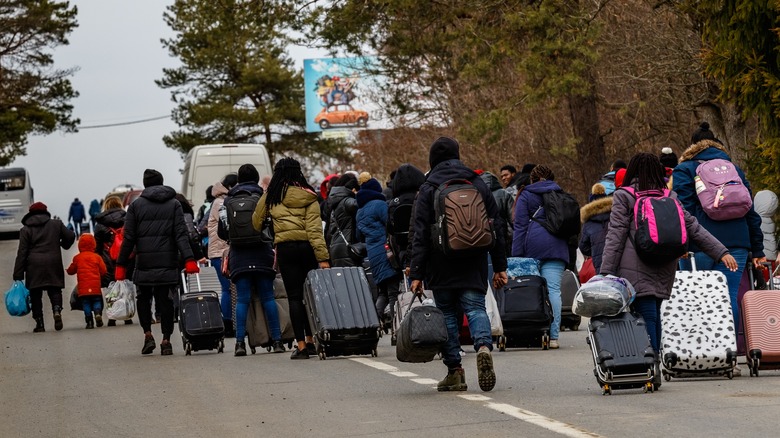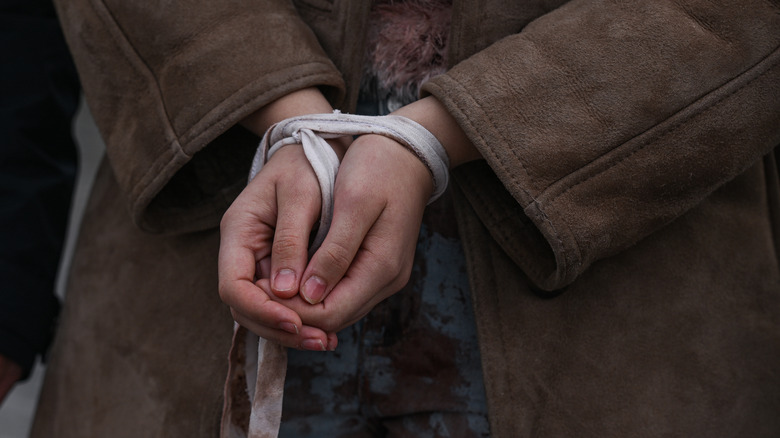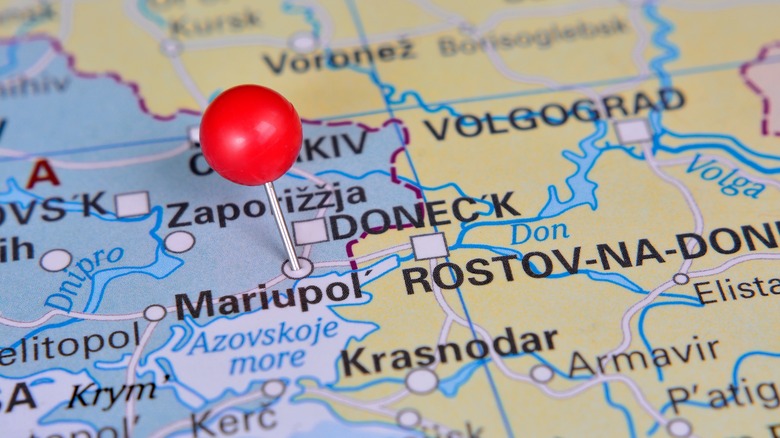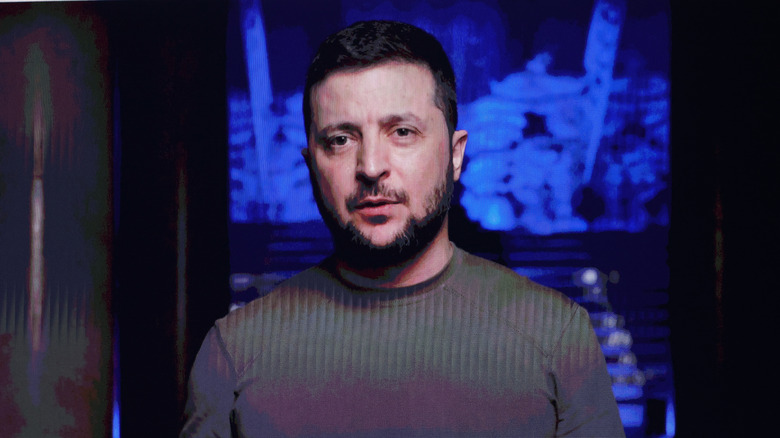Chilling Details About The Bucha Massacre
Content warning: the following article contains mentions of sexual abuse and acts of violence, as do the links attached in the text.
When Russia invaded Ukraine in February 2022, it seemed imminent that human tragedy would follow. However, few were prepared for one of the most terrifying incidents in this latest chapter in the lengthy and immensely complicated Ukraine-Russia conflict. For roughly one month, the Russian forces occupied a town called Bucha (via Associated Press). The occupation was a cruel and gruesome one, and once the invading troops left the town behind, Bucha's streets were awash with the dead, many of whom had their hands tied behind their backs.
There's still no way to know for sure just how many people died in the massacre. According to USA Today, the grim task of counting the dead has affirmed over 320 victims, as of April 6, but the final tally could be even larger. The New York Times has since put the figure at 360. "We are being destroyed and exterminated," Ukraine's President Volodymyr Zelensky spoke of Bucha's events on CBS Face the Nation. "And this is happening in the Europe of the 21st century."
The true scale of the horror is still unfolding, but it's already clear that the events of Bucha will live in infamy. Now, here's a closer look at the chilling details about the Bucha massacre. As mentioned, the subject matter means that the following contains mentions of various wartime atrocities, so reader discretion is advised.
First reports of Bucha's atrocities were heartbreaking
One of the first times Bucha entered the international lexicon as a location of dire tragedy and human suffering was on March 8, when the Kyiv Independent reported that the Russian military had killed three people who were returning from a food assistance delivery run to a local dog shelter. The victims perished when a heavy Russian vehicle unexpectedly opened fire on them.
The focus of the story was on the three people who died in the attack, but rereading it now, it contains multiple red flags for the atrocities that were transpiring in the area. There are mentions of residents hiding in the basement from constant enemy fire, and the people who witnessed the shooting said that the Russian soldiers knew full well that they were opening fire on civilians. "The car was (obviously) civilian," one victim's friend stated. "Maxym was wearing a hat with a pom pom. They didn't look like the military at all."
In April, The Guardian published a survivor's account from an even earlier incident in March 5. Two families attempted to flee from Bucha to western parts of Ukraine by car, only to be attacked and gunned down by a Russian vehicle during their escape attempt. According to Bellingcat, Ukrainian troops regained control of the area on April 1, which is when the true scale of the Bucha massacre became known. These accounts, however, make clear that the situation was already extremely dire many weeks earlier.
The Russian occupiers descended into violence over the weeks
The Bucha residents who survived the Russian occupation have harrowing tales of the attackers' descent from relative indifference to stressed-out, wanton killing, according to Associated Press. At first, the Russians seemed to operate under the assumption that they'd only stay in Bucha for three days, presumably expecting to invade the nearby Kyiv in the immediate future.
When Kyiv remained elusive and the soldiers stayed in place, many people of Bucha described a change in their mentality. As time went by, the soldiers grew visibly frustrated. They started looting, killing, and tormenting the residents, sometimes citing orders or explaining themselves, but often just wreaking havoc with little warning or explanation. "They needed to kill someone," one resident said. "And killing civilians is very easy." Per Der Spiegel, witnesses have also noted that the initial, less violent troops in the area were quite young, but things changed when other soldiers arrived.
At various points, the Russian soldiers were reportedly trying to locate certain people, inspecting documents and phones. However, eyewitnesses say that random killings absolutely happened (via the BBC). "They didn't ask anything or say anything, they just killed him," one victim's wife said. Some Bucha residents described easier experiences than others, and a few were even surprisingly spared when they were all but certain that they wouldn't survive. Regardless, many died, and countless others had to endure numerous horrors, often in abysmal lockdown conditions without electricity and with inadequate supplies.
The occupiers may have used children as human shields
According to The New York Times, before the Russian invasion of Ukraine, Bucha was known as a cozy and comfortable suburbia with a nice location near Kyiv and plenty of modern amenities. However, its residents spent a month in the extremely unfortunate position of being occupied by Russian troops after Ukrainian forces had hurt the invaders in an earlier attack. When the Ukrainians eventually advanced to the area to challenge the Russians, the ensuing battles ultimately caused the occupiers to retreat. The fighting brought an extra element to the civilians' terror, because as The Guardian reports, there are allegations that it prompted the Russian forces to take children from the area and use them as human shields for their military vehicles.
This is a tactic that the Russian forces have used in multiple regions of Ukraine, according to Colonel Oleksandr Motuzyanyk of Ukraine's Ministry of Defense. "Enemies have been using Ukrainian children as a living shield when moving their convoys, moving their vehicles," Motuzyanyk said. "Russian soldiers have used Ukrainian children as hostages, putting them on their trucks. They're doing it to protect their vehicles when moving."
Ukraine's attorney general is reportedly investigating these reports for future use in potential court cases.
Russia claims that the Bucha massacre is fake
Russia's reaction to reports of the Bucha massacre has been that of strong denial. According to The Guardian, the country has claimed that it has nothing to do with the bodies on the streets. Instead, Russia has attributed them to Ukraine, claiming that the display of the dead is a part of Ukraine's tactic to discredit its adversary by either placing human remains on the streets after Russian soldiers left, or even using live people to pose as dead civilians (via Associated Press). Per Reuters, Russia's Foreign Minister, Sergey Lavrov, dismissed the Bucha massacre as an attempt to disrupt negotiations between Ukraine and Russia. "We are inclined to think the reason is a desire to find a pretext to break off the negotiations that are being conducted," Lavrov stated.
However, Russia's claims of innocence run somewhat counter to satellite images of the region, which show that there were already bodies on the streets when Russian forces held the area. In fact, some of them were there very early on during the occupation. It appears such photographic proof hasn't really swayed Russia, though. Per The Guardian, the country's media has stuck to its guns and presented the Bucha massacre as fake news, offering various alternative explanations for it — up to and including blaming the U.K.
Captured radio transmissions could prove chilling things about Russia's strategy
Russia has denied that its troops have anything to do with the Bucha massacre, and according to The Washington Post, the country has outright claimed that the entire thing is a hoax that's meant to discredit its military. As it happens, however, the German foreign intelligence service BND has intercepted Russian military radio communications that might eventually provide concrete audio proof of Russia's involvement in the incident (via Der Spiegel).
There are, of course, plenty of Bucha survivors and witnesses who have confirmed that Russian soldiers were the perpetrators of the massacre. However, in case that isn't enough, BND has reportedly managed to intercept various Russian radio transmissions, in which soldiers casually discuss killing people in situations that resemble the conditions in which some Bucha massacre victims' bodies were later found. It's worth noting that the transmissions have not yet been conclusively linked to Bucha, though, even if the events they describe do seem to match the events in the area.
Though even individual radio transmissions of this nature sound pretty damning if they can be conclusively linked to Russian activity in Bucha, Der Spiegel's sources have indicated that the big picture they form together is even worse. This is because said big picture would appear to indicate that the Bucha massacre was no mere accident, but a calculated military tactic.
The Russians booby-trapped bodies
For those who have seen the images, the bodies strewn on the streets are one of the most enduring images of the Bucha massacre and the invasion of Ukraine — but according to The Washington Post, some of them had potential for far more tragedy than you might have assumed. Reportedly, the Russian soldiers turned some of the bodies into dangerous, explosive booby traps, using mines and tripwire. Per ABC News Australia, this has evidently been a common enough practice that Ukraine's president Volodymyr Zelensky specifically mentioned it when speaking of the atrocities in Bucha. "Hundreds of people were killed," he said. "Tortured, executed civilians. Corpses on the streets. Mined areas. Even the bodies of the dead were booby-trapped."
The Ukrainian forces knew about the possibility of explosive traps, and per Associated Press, they've exercised caution. Instead of carrying the bodies, some of them have used alternate methods like cables to move them from a safe distance. Unfortunately, a video of soldiers using this system has led some people to claim that they're staging the massacre ... instead of dealing with its aftermath.
International response was swift and damning ... except for China
With the world's eyes already on Ukraine, the news about the Bucha massacre prompted swift and strong reactions from the international community (per The Guardian). Representatives of prominent European countries condemned the attack in no uncertain terms. The President of the United States of America, Joe Biden, floated the option of a war crime trial for Russia's President, Vladimir Putin (via CNN). According to UN News, the Secretary-General of the United Nations, António Guterres (pictured), has called for an independent investigation of the incident.
However, there's one major dissonant chord in the sea of international outrage. According to CNN, Chinese media has reported the events of Bucha in much the same way Russia has, claiming that the massacre was staged by Ukraine. The country has also added its own twist to the situation by alleging that the U.S. is ultimately responsible for the Russia-Ukraine war.
Bucha's population dropped almost to nothing
Hundreds of people died in the Bucha massacre, but as Bucha's mayor, Anatoliy Fedoruk, told Deutsche Welle after the Russian troops left the area, the foreign military's occupation of the area had an even more staggering effect to the area's population. The vast majority of the locals were forced to flee the area, which was left borderline uninhabitable. As a result, the invasion actually dropped the area's population to almost nothing.
"Bucha had 50,000 residents," Fedoruk said. "With the surrounding villages, there was a total of 67,000. Currently, there are 3,700 people in Bucha but the number is slowly rising as specialists return to repair critical infrastructure. In other parts of the district, the population has fallen by 30%."
Though Bucha is now under Ukraine's control, the occupation left its infrastructure largely wrecked, and the authorities have been busy at work to restore the city's functionality and to identify the victims of the massacre. However, it doesn't exactly help matters that the occupiers left behind mines, and even the bodies that lay on the streets have to be checked for explosive traps, according to the Associated Press.
Killing wasn't enough for the perpetrators
As ABC News tells us, death was but one of the many horrors the residents of the Bucha area were subjected to. The full extent of their terrors was such that the authorities described one particular room they found as a "torture chamber." Per the Associated Press, the Russian soldiers could be highly unpredictable and prone to cruel tricks, like forcing a civilian to hold a grenade in his armpit while threatening to pull the pin. A report by The New York Times opens up the sheer scale of cruelty and torture, and makes clear that from constant threat by snipers and starvation to loathsome sexual violence, Bucha's Russian occupation offered a number of truly hellish fates for the remaining residents. Per Newsweek, even children weren't safe from horrifying atrocities.
"The cases we documented amount to unspeakable, deliberate cruelty and violence against Ukrainian civilians," stated Hugh Williamson of Human Rights Watch about the Russian military's crimes against civilians in this and other areas of Ukraine.
If you or anyone you know has been a victim of sexual assault, help is available. Visit the Rape, Abuse & Incest National Network website or contact RAINN's National Helpline at 1-800-656-HOPE (4673).
An expert warns that Bucha could be just the beginning
As horrifying as the Bucha massacre is, some experts have already noted that it may not be the last — or even the worst — tragedy to come from Russia's invasion of Ukraine.
Father Patrick Desbois, a Catholic priest who specializes in uncovering hitherto unknown massacres, has recently turned his attention to Ukraine, and in an interview with France 24, the French clergyman discussed his work to interview the people of Ukraine to uncover the true horrors of their situation. Desbois expressed astonishment for the Ukrainians' resilience, but made very clear that Bucha might not be the only place that has to endure such atrocities during the war. He predicted that the besieged city of Mariupol (via The Guardian) might turn out to be much worse once the true scale of its destruction is revealed ... and that even this might only be the beginning. "Everyone is revolted by Bucha, but I wonder what it will be like when Mariupol is liberated?" Desbois said. "We can expect much larger scenes of massacres. There will be Buchas everywhere."
To get an idea of the scale of terror he's worried about, Bucha had an estimated 50,000 residents before the war and the massacre (via Deutsche Welle). Per the BBC, as of March 21, there were 200,000 people trapped in Mariupol, and per Der Spiegel, radio chatter captured by German intelligence officials indicate that horrifying things may have happened there, as well.
The Bucha massacre may have given Ukraine a fast track to EU membership
There are no silver linings when it comes to events like the Bucha massacre, but it seems that the tragic event has already impacted Ukraine's future. Per Reuters, the president of the European Commission, Ursula von der Leyen, visited President Volodymyr Zelensky after Ukraine had regained control of the Bucha area. She also went to see Bucha herself. "We have seen the cruel face of Putin's army. We have seen the recklessness and the cold-heartedness with which they have been occupying the city," she said of the undoubtedly harrowing experience.
During this trip, von der Leyen promised Ukraine a highly sped-up process to join the European Union. "It will not as usual be a matter of years to form this opinion but I think a matter of weeks," she estimated.
Per The Conversation, the European Union and Ukraine have a friendly, if somewhat convoluted, history, and though they've been warming to each other in recent years, Radio Free Europe estimated in February 2022 that, despite Zelensky's publicly stated wishes to join as soon as possible, Ukraine's chances for a quick membership seemed slim. Recent developments indicate otherwise, and while the Bucha massacre may be just one piece of the puzzle, the fact that it featured so prominently during von der Leyen's membership fast-track visit implies that it might have been the thing that ultimately tipped the scales in favor of bringing Ukraine into the EU.

